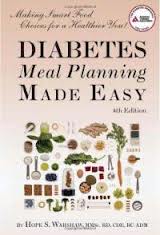Got Diabetes? Necessary or Needless to Follow 'A Diabetic Diet'?
 Is there ‘a diabetic diet’? NO!
Is there ‘a diabetic diet’? NO!
According to the American Diabetes Association (ADA), and this has been true since 1994 – nearly 20 years, there is no one diabetic diet that represents THE prescription for THE way ALL people with diabetes should eat.
Are there ‘diabetic foods’ which people with diabetes should buy? NO!
Foods labeled ‘diabetic’ or ‘diabetic-friendly’ carry a halo of being better-for-you than unprocessed, unadulterated and unlabeled foods. But, it’s just not so.
So, then what’s the eating plan for people with diabetes today?
The nutrition recommendations from the American Diabetes Association, last updated in 2008, echo the healthy eating recommendations of the United States Dietary Guidelines for Americans last revised in 2010.
These recommendations reflect the growing body of evidence that a plant-based eating plan can help people achieve and maintain a healthy body weight and prevent and manage chronic diseases, like diabetes, heart disease and certain cancers.
Translated and simply stated here are the basics of a healthy eating plan to manage diabetes:
- Eat about half your calories from nutrient dense carbohydrate-rich foods. That’s whole grains, fruits, vegetables, and low or no-fat dairy foods. There is very little solid science to support the notion that people with diabetes should limit the amount of carbohydrate they eat. In fact, there’s plenty of science to indicate the converse. That is as long as the carbohydrate is from fiber-filled, nutrient-dense foods and not processed foods with lots of added sugars. Reality is our problem with carbohydrates is NOT quantity, but quality. Too much added sugars, especially in the form of sugary drinks.
- Up your fiber consumption. Americans consume nowhere near enough fiber. That’s because we’re light on whole grains, legumes, fruits and vegetables. Choose fiber-filled whole grains rather than refined grains and processed cereals, crackers, breads, etc. Check the Nutrition Facts for the fiber content per serving. Eat at least 5 servings of fruits and vegetables each day. They’re nutrient dense and relatively low in calories.
- Drink at least 2 to 3 (depending on age, sex, calorie and calcium needs) 8 ounce servings of milk (or eat yogurt) a day. Dairy foods provide calcium, potassium and more.
- Limit red meat. Purchase lean cuts to minimize the saturated fat. Prepare them without added fat or oil. Serve no more than 3 ounces (cooked) at a time. Also limit processed meats. Research increasingly points a finger at the nitrites and nitrates and high sodium content of these foods related to the risk of type 2 diabetes and some cancers.
- Keep saturated fat to a minimum by eating limited amounts of full-fat dairy foods, cheese, red meats and other protein-based foods and solid fats, like butter or lard. Choose more seafood, poultry and non-animal sources of protein like beans and legumes to meet your protein needs. Also eat as little trans fats, a type of saturated fat, as possible.
- Choose and use healthier liquid oils, such as canola, olive, and soybean oil. They contain healthier fats. Use small amounts of nuts, avocado which contain healthy fats.
- Limit sugary foods and sweets. This includes refined snack foods, baked goods, candy and sweet desserts. Put a lid on the amount of beverages sweetened with added sugars These foods are high in calories and low in nutrition.
It’s in our nature to want to find a one-size-fits-all answer to the question What Should People with Diabetes Eat? But it’s not a simple question and there’s not just one answer for the millions of people with diabetes.
Consider the challenge. For starters, people with diabetes come in all ages, shapes and sizes. Plus some people with diabetes require insulin injections to control their glucose levels and can learn to adjust the amount of rapid acting insulin they take to the amount of food (particularly carbohydrate) they eat. Many people with prediabetes or type 2 diabetes are overweight. For people with prediabetes and those with relatively early type 2 diabetes, losing 10 to 20 pounds can provide enormous benefit to control of blood glucose, blood pressure and blood lipid (fats).
Perhaps the biggest challenge is that people come to their diagnosis of diabetes or prediabetes with preexisting food preferences and eating habits. And boy are these ingrained in our DNA and quite a job to change.
Get the picture? 
When you learn you have diabetes, don’t think you need to dramatically change your eating habits and food choices, follow “a diabetic diet,” purchase “diabetic foods” or prepare “diabetic-friendly recipes.” You may need, over time, to make significant changes, but reality is most people don’t experience long lasting changes when they’re made dramatically. Research repeatedly shows that people experience much greater success making changes slowly and gradually overtime.
The changes you make should focus on what’s possible for you as an individual based on what you are willing to do and change. Take steps - one at a time – to transition to healthier eating habits. Pick the easiest to accomplish goals first. Experience success which will fuel further behavior changes.
Need more information about how to change your eating habits and plan and prepare healthy meals? Pick up a copy of my book Diabetes Meal Planning Made Easy (American Diabetes Association).

